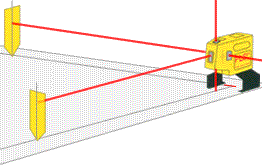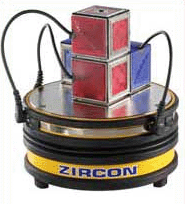The Bright Red String
By Tom Inglesby
 Since ancient masons checked their work with string made of goat hair, wool or fiber, bricks and blocks have been aligned with "low-tech" methods. That is starting to change.
Since ancient masons checked their work with string made of goat hair, wool or fiber, bricks and blocks have been aligned with "low-tech" methods. That is starting to change.
Over the past millennium, the typical brick and block mason's tool kit hasn't been heavy with technology. Among the hammers, chisels, trowels and scrapers you'll find a roll of mason's line, whether to support a plumb bob or to align a course of brick. These have been, and continue to be, the tools of the trade.
Close at hand are the folding rule for short distance measurement and the long level for... well... for leveling. Smaller levels for line use, perhaps, can be found in the kit's pockets. All in all, a simple, low-tech tool bag.
Every contractor has basic alignment tasks to perform on the job site. No project can be completed without layout of the work, installation of material, and quality control. Each of these functions is accomplished by determining plumb, level and square reference. Nothing can be built without them.
The plumb bob and water or bubble level are ancient tools used to establish vertical or horizontal reference. Today, contractors have a choice of carpenter levels, laser levels, rotary levels and some hybrid laser products.
For a number of years, laser tools that allow grading and leveling have been on the market and used by larger contractors in pouring slabs and footings, grading foundation areas and other pre-masonry aspects of the job site. The big drawback was cost; units could and still do run into thousands of dollars. But electronics manufacturers have always found ways to lower prices as popularity brings benefits of scale. Mason contractors are starting to see that effect with the laser as multiple industries find uses for them.
And like most electronics today, miniaturization is giving us the laser adapted to smaller packaging and even handheld units such as those mounted on levels instead of tripods. Multiple axes can be found in single units, allowing vertical, horizontal and adjustable angles to be directed from a single unit.
Rotary Units
The king of the laser levels, though, is the rotary unit. In this unit, the laser beam ? a series of dots strobing rapidly ? spins around in a circle. It spins fast enough that you actually see a line, not dots. Because you and OSHA don't want eye injuries, the power of the laser is strictly limited. It will still be visible in a normally lit interior at a reasonable distance and usually visible at a much-reduced distance outdoors and in daylight. Laser enhancement glasses will make the laser line more visible at a greater distance by filtering out competing colors.
To use a rotary laser outside, you will be better off using a detector or receiver, a small box with a sensing strip tuned to the frequency (color) of the laser light. This picks up the signal you can't see with the unaided eye in normal outdoor light.
A good example of the rotary laser level is the PLS-5X from Pacific Laser Systems (PLS) in Sausalito, Calif. This self-leveling, point-to-point alignment laser tool is designed for layout of control points and lines in outdoor conditions, especially in bright sunlight. Working range is 250 feet and more with an accuracy of one-eighth inch at 100 feet. Market price is about $500, and they are available from distributors.
One highly practical application is the self-leveling aspect. Another rotating laser level that includes a self-leveling function within the laser-sending unit is the Porter-Cable Crossliner. It has a built-in sensor that causes the level and/or plumb beam to immediately flash when the tool is out of level. Internally, a self-leveling system based on a pendulum effectively helps to eliminate errors where vibration, bumps and temperature changes can adversely impact the unit.
The Crossliner, sold through distributors such as Laser Products Industries, Romeoville, Ill., is a two-beam level and plumb unit that is tripod-mounted or can stand on the footing or slab when in use. The scanning beams show plumb (vertical) and level (horizontal), while the rotating base allows close angle setting. Market prices vary, of course, but the unit can often be found for less than $250 ? the Laser Products web site showed it at $199 the last time we looked.
 Laser Products Industries also carries its own line of laser levels called the Laser Square line. Smaller than the Crossliner, the SL-24, for example, can be set on a corner of a batter board set-up and set 90 or 45 degree angles with a light pattern extending as much as 500 feet indoors (low-light levels) and 150 feet outdoors (daylight). This one unit is capable of checking level, square and plumb and yet is easily carried on one hand or in a pouch on the belt. Using the dot pattern method, the dots can travel out from the unit along a wall course and show bulges or rises as small as a fraction of an inch.
Laser Products Industries also carries its own line of laser levels called the Laser Square line. Smaller than the Crossliner, the SL-24, for example, can be set on a corner of a batter board set-up and set 90 or 45 degree angles with a light pattern extending as much as 500 feet indoors (low-light levels) and 150 feet outdoors (daylight). This one unit is capable of checking level, square and plumb and yet is easily carried on one hand or in a pouch on the belt. Using the dot pattern method, the dots can travel out from the unit along a wall course and show bulges or rises as small as a fraction of an inch.
For those looking for a low-end all-in-one package, Zircon offers a rotating laser kit. It's a full function unit comprised of an auto-leveling base (manual-leveling base available) with modular Qube lasers. The Qube lasers produce lines or dots, and there are accessories available to customize the basic rotary laser. Kits start at only $60 for the manual base or $100 for the auto-leveling base and are available directly from Zircon, Campbell, Calif.
Other Laser Applications
In keeping with its name, Laser Square also has a builder's square with a laser mounted in the 90-degree angle. One person can square up to 150 degrees indoors, 70-80 degrees outdoors, and even more with a target. Both beams intersect at the inside corner of the framing square, so you can push the inside corner of the square up to a nail and you'll be squaring from that nail. To shoot perpendicular from an existing wall, bump one edge against the wall and the other beam is exactly 90 degrees from the wall. Measure out the desired distance, mark your spot, and snap your lines.
Lasers mounted in and on standard and torpedo levels are becoming common as the prices drop to levels ? pun intended ? equal to standard bubble levels. While doing an Internet search, we found Northern Industrial Tools laser levels for as little as $25, and other brands are comparably priced. Typical of the low-end laser level, the Northern 36-inch unit features two vials for horizontal and vertical measurement from minus 90 to plus 90 degrees. The level projects a laser dot, horizontal line, vertical line and laser cross pattern with a working distance of 150 feet in daylight or 300 feet in low-light conditions. This level is made of aluminum, as are most laser/bubble levels.
An aluminum torpedo level with laser functions by RoboToolz, sold through Porter-Cable and other distributors, is called the Robosquare. The three beams provide simultaneous level, plumb and square reference points with all beams starting from the same light source. It has a magnetic base, can be tripod-mounted, and has through holes for attaching it to various surfaces such as studs, beams and pipes.
Whether the laser/bubble levels are ready for the stress and strain, not to mention dirt and mortar, found on mason jobs is still to be proven. Each generation has been sturdier and more resistant to the harsh construction environment. But electronics never have liked what is normal on a construction site, so we'll withhold judgment until more experience is gained. It might be a good idea, even with the best laser levels, to have a backup standard level, some good mason's line and a plumb bob or two handy.
About the Author
Tom Inglesby is a San Diego-based freelance writer whose work has appeared in numerous online and print publications. He is the winner of the Construction Writers Association's 2002 Boger Award for Special Reports.


















